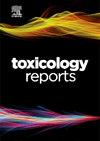Developmental lead exposure and aggression in male rats: Influences of maternal care and environmental enrichment
Q1 Environmental Science
引用次数: 0
Abstract
Developmental lead (Pb) exposure results in a variety of cognitive deficits and behavioral issues including increased antisocial behavior and aggression. This study investigated the effect of developmental Pb exposure on aggression and violent behavior in male rats and the potential modulatory influences of quality of maternal care and enriched/non-enriched housing conditions. Long-Evans male rats with or without Pb exposure (perinatal or early postnatal) from low or high maternal care mothers (based on amounts of licking/grooming and arched-back nursing) were randomly assigned to live in enriched or non-enriched environments at weaning. At postnatal day 120–190, offensive aggression was assessed using a resident intruder test. Clinch attack (CAK) frequency and latency, and occurrence of biting events were observed to determine violent behavior. Both perinatal and postnatal Pb-exposed rats were significantly more aggressive and showed more violent behavior, compared to non-Pb-exposed animals, regardless of level of maternal care and environmental enrichment. High maternal care significantly lowered the proportion of animals with short CAK latencies and enriched housing significantly lowered the occurrence of biting events. These results suggest that high maternal care and enriched housing may potentially modify expression of violent aggressive behavior in rats with early life Pb exposure.
发育性铅暴露与雄性大鼠的攻击性:母性照顾和环境富集的影响
发育性铅暴露会导致多种认知缺陷和行为问题,包括反社会行为和攻击行为的增加。本研究探讨了发育期铅暴露对雄性大鼠攻击和暴力行为的影响,以及母性照料质量和强化/非强化住房条件的潜在调节作用。有或没有铅暴露(围产期或产后早期)的Long-Evans雄性大鼠来自低或高母亲护理(基于舔/梳理和弓背护理的数量),在断奶时随机分配到富或非富环境中生活。在出生后120-190天,使用常驻入侵者测试评估进攻性攻击。观察握紧攻击(CAK)的频率和潜伏期,以及咬伤事件的发生来确定暴力行为。与未暴露于铅的动物相比,无论母性护理水平和环境富集程度如何,围产期和产后暴露于铅的大鼠都明显更具攻击性,表现出更多的暴力行为。高母性护理显著降低了CAK潜伏期短的动物比例,丰富的住房显著降低了咬人事件的发生。这些结果表明,高母亲照顾和丰富的住房可能会改变早期Pb暴露大鼠暴力攻击行为的表达。
本文章由计算机程序翻译,如有差异,请以英文原文为准。
求助全文
约1分钟内获得全文
求助全文
来源期刊

Toxicology Reports
Environmental Science-Health, Toxicology and Mutagenesis
CiteScore
7.60
自引率
0.00%
发文量
228
审稿时长
11 weeks
 求助内容:
求助内容: 应助结果提醒方式:
应助结果提醒方式:


